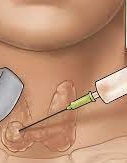A Review of Thyroid Dysfunction due to COVID-19
Please click to this link:
A Review of Thyroid Dysfunction due to COVID-19
Coronavirus disease 2019 (COVID-19) affects thyroid function.
These changes are due to the direct impact of the virus on thyroid
cells via angiotensin-converting–enzyme 2 (ACE2) receptors,
inflammatory reaction, apoptosis in thyroid follicular cells,
suppression of hypothalamus-pituitary-thyroid axis,
an increase in activity of adrenocortical axis,
and excess cortisol release due to cytokine storm
of severe acute respiratory syndrome coronavirus 2 (SARS-CoV-2).
Euthyroid sick syndrome (ESS), thyroiditis, clinical and subclinical
hypothyroidism, central hypothyroidism, exacerbation of
underlying autoimmune thyroid disease, and clinical and
subclinical hyperthyroidism can be associated with coronavirus.
Adjuvants in coronavirus vaccines induce autoimmune/inflammatory syndrome
known as vaccine adjuvants (ASIA) syndrome.
Thyroiditis and Graves’ disease have been reported
to be associated with ASIA syndrome after some coronavirus
vaccinations. Some coronavirus medications, such as hydroxychloroquine,
monoclonal antibodies, lopinavir/ritonavir, remdesivir, naproxen,
anticoagulants, and glucocorticoids can also affect thyroid tests,
and correct diagnosis of thyroid disorders will be more difficult.
Conclusion: Changes in thyroid tests may be one of the most
important manifestations of COVID-19.
These changes can be confusing for clinicians and can lead to
inappropriate diagnoses and decisions.
Prospective studies should be conducted in the future to increase
epidemiological and clinical data and optimize the management
of thyroid dysfunctions in patients with COVID-19.
Keywords: Coronavirus disease 2019; severe acute
respiratory syndrome coronavirus 2; thyroid hormone;
thyroiditis; autoimmune disease; hyperthyroidism;
hypothyroidism; euthyroid sick syndrome; pandemic;
subclinical thyroiditis; painless thyrotoxicosis; thyroid dysfunction; thyrotoxicosis.
The author of the article:
Dr. Alireza Arefzadeh,
Endocrinologist
درمان چاقی شکم با آر اف درمان چاقی شکم چاقی شکم آر اف شکم آر اف کویتیشن اولتراسوند فوق تخصص غدد در تهران فوق تخصص غدد تهران بهترین فوق تخصص غدد تهران شمال جنوب شرق غرب بهترین فوق تخصص غدد در تهران بهترین فوق تخصص غدد تهران بهترین فوق تخصص غدد در شمال تهران بهترین فوق تخصص غدد در غرب تهران دکتر غدد در تهران بهترین دکتر متخصص غدد در تهران لیست پزشکان فوق تخصص غدد در تهران بهترین دکتر فوق تخصص غدد در تهران بهترین متخصص غدد در تهران متخصص غدد تهران بهترین متخصص غدد تهران متخصص غدد در تهران متخصص تیروئید تهران متخصص دیابت تهران متخصص تیروئید متخصص دیابت متخصص دیابت در تهران آدرس دکتر متخصص غدد در تهران آدرس دکتر فوق تخصص غدد در تهران متخصص تیروئید در تهران دکتر متخصص تیروئید در تهران بهترین فوق تخصص غدد تهران شمال جنوب شرق غرب متخصص داخلی دیابت تیروئید چاقی رشد بلوغ نازایی متخصص غدد خوب تهران دکتر متخصص غدد خوب در تهران دکتر متخصص دیابت در تهران دکتر متخصص تیروئید در تهران کلینیک فوق تخصصی غدد دکتر فوق تخصص غدد تیروئید کلینیک فوق تخصصی تیروئید دکتر متخصص غدد تیروئید دکتر متخصص غدد دیابت دکتر متخصص دیابت دکتر فوق تخصص غدد دیابت متخصص غدد تیروئید فوق تخصص غدد دیابت بهترین دکتر فوق تخصص غدد در تهران بهترین دکتر فوق تخصص تیروئید در تهران بهترین دکتر فوق تخصص دیابت در تهران بهترین دکتر متخصص رشد در تهران بهترین دکتر فوق تخصص رشد در تهران کلینیک فوق تخصصی دیابت کلینیک فوق تخصصی دیابت در تهران معرفی دکتر فوق تخصص غدد در تهران دکتر غدد خوب در تهران دکتر خوب غدد در تهران دکتر علیرضا عارف زاده فوق تخصص غدد دکتر علیرضا عارف زاده دکتر عارف زاده فوق تخصص غدد Dr alireza arefzadeh بهترین فوق تخصص غدد تهران شمال متخصص غدد شرق غرب جنوب فوق تخصص غدد بهترین فوق تخصص غدد بهترین فوق تخصص غدد تهران بهترین فوق تخصص غدد در تهران فوق تخصص غدد در تهران فوق تخصص غدد تهران فوق تخصص خوب غدد تهران فوق تخصص خوب غدد شمال تهران بهترین فوق تخصص غدد شرق تهران بهترین شمال تهران متخصص غدد بهترین متخصص غدد جنوب تهران بهترین متخصص غدد غرب تهران بهترین فوق تخصص غدد شمال تهران بهترین فوق تخصص غدد در شمال تهران متخصص غدد متخصص غدد تهران بهترین متخصص غدد تهران متخصص غدد در شمال تهران بهترین متخصص غدد در تهران فوق تخصص غدد در شمال تهران بهترین فوق تخصص غدد غرب تهران بهترین فوق تخصص غدد در غرب تهران بهترین فوق تخصص متخصص غدد شمال تهران دکتر غدد خوب در تهران دکتر خوب غدد در تهران دکتر علیرضا عارف زاده فوق تخصص غدد دکتر علیرضا عارف زاده Dr alireza arefzadeh





